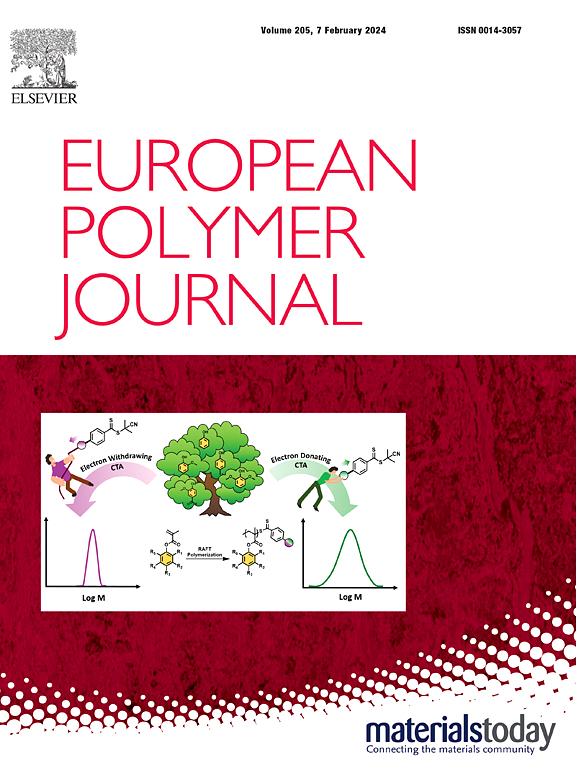Dynamically self-degradable, injectable and self-healing 6-deoxy-6-arginine grafted chitosan hydrogels for wounds healing
IF 5.8
2区 化学
Q1 POLYMER SCIENCE
引用次数: 0
Abstract
6-Deoxy-6-arginine grafted chitosan (DAC) is cross-linked with dibenzaldehyde-functionalized polyethylene glycol (DF-PEG) via the acylhydrazone (–N=CH–) bonds, which can be utilized for the encapsulation of metformin (MET). The resultant injectable DAC/DF-PEG/MET (DDM) hydrogels highlight well-behaved antibacterial and anti-inflammatory activity as well as self-healing capability. More interestingly, the DDM hydrogels exhibit appealing dynamic self-degradability. The electrostatic attraction between DAC and DF-PEG is significantly weakened at slightly alkaline surface (pH 7.0–8.0) that is the characteristic of skin wounds, resulting in the swelling of the hydrogels and the release of MET. As the wounds gradually get healed, the skin tissue turns to be weakly acidic (pH 4.0–6.0), leading to the hydrolysis of the –N=CH– bonds between DAC and DF-PEG. Therefore, the DDM hydrogels can be dynamically self-degraded during the wound healing process. Owing to the injectability and self-healing properties, the DDM hydrogels are suitable for use as the wound dressing for the wounds in any shape. The developed DDM hydrogels also display excellent hemocompatibility and cytocompatibility, indicating that they might be a potential wound dressing for skin wounds.

动态自降解、可注射、自修复的6-脱氧-6-精氨酸接枝壳聚糖水凝胶用于伤口愈合
6-脱氧-6-精氨酸接枝壳聚糖(DAC)通过酰基腙(- n =CH -)键与二苯甲醛功能化聚乙二醇(DF-PEG)交联,可用于二甲双胍(MET)的包封。所得的可注射DAC/DF-PEG/MET (DDM)水凝胶突出表现出良好的抗菌和抗炎活性以及自愈能力。更有趣的是,DDM水凝胶表现出吸引人的动态自降解性。在皮肤伤口的微碱性表面(pH 7.0-8.0), DAC和DF-PEG之间的静电吸引力明显减弱,导致水凝胶肿胀,MET释放。随着伤口逐渐愈合,皮肤组织呈弱酸性(pH 4.0-6.0),导致DAC和DF-PEG之间的- n =CH -键水解。因此,DDM水凝胶可以在伤口愈合过程中动态自降解。由于DDM水凝胶具有可注射性和自愈性,适合作为任何形状伤口的创面敷料。所制备的DDM水凝胶还具有良好的血液相容性和细胞相容性,表明其可能是一种潜在的皮肤伤口敷料。
本文章由计算机程序翻译,如有差异,请以英文原文为准。
求助全文
约1分钟内获得全文
求助全文
来源期刊

European Polymer Journal
化学-高分子科学
CiteScore
9.90
自引率
10.00%
发文量
691
审稿时长
23 days
期刊介绍:
European Polymer Journal is dedicated to publishing work on fundamental and applied polymer chemistry and macromolecular materials. The journal covers all aspects of polymer synthesis, including polymerization mechanisms and chemical functional transformations, with a focus on novel polymers and the relationships between molecular structure and polymer properties. In addition, we welcome submissions on bio-based or renewable polymers, stimuli-responsive systems and polymer bio-hybrids. European Polymer Journal also publishes research on the biomedical application of polymers, including drug delivery and regenerative medicine. The main scope is covered but not limited to the following core research areas:
Polymer synthesis and functionalization
• Novel synthetic routes for polymerization, functional modification, controlled/living polymerization and precision polymers.
Stimuli-responsive polymers
• Including shape memory and self-healing polymers.
Supramolecular polymers and self-assembly
• Molecular recognition and higher order polymer structures.
Renewable and sustainable polymers
• Bio-based, biodegradable and anti-microbial polymers and polymeric bio-nanocomposites.
Polymers at interfaces and surfaces
• Chemistry and engineering of surfaces with biological relevance, including patterning, antifouling polymers and polymers for membrane applications.
Biomedical applications and nanomedicine
• Polymers for regenerative medicine, drug delivery molecular release and gene therapy
The scope of European Polymer Journal no longer includes Polymer Physics.
 求助内容:
求助内容: 应助结果提醒方式:
应助结果提醒方式:


